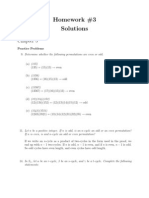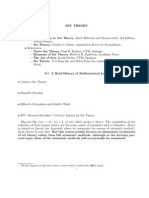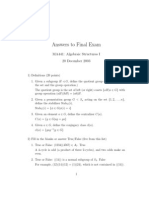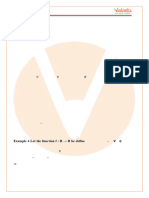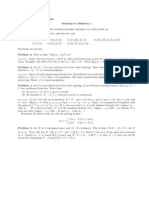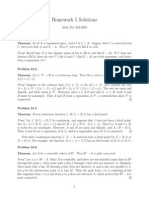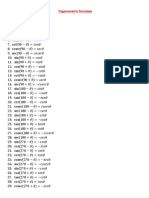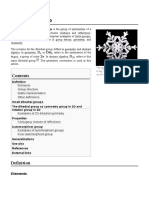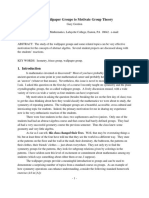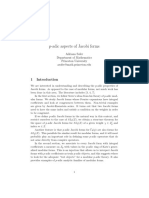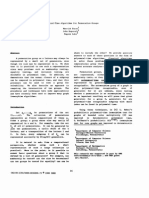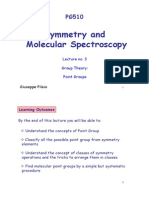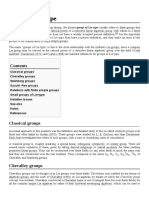Homework #4 Solutions (Due 10/3/06) : Niversity of Ennsylvania Epartment of Athematics
Homework #4 Solutions (Due 10/3/06) : Niversity of Ennsylvania Epartment of Athematics
Uploaded by
bond12314Copyright:
Available Formats
Homework #4 Solutions (Due 10/3/06) : Niversity of Ennsylvania Epartment of Athematics
Homework #4 Solutions (Due 10/3/06) : Niversity of Ennsylvania Epartment of Athematics
Uploaded by
bond12314Original Description:
Original Title
Copyright
Available Formats
Share this document
Did you find this document useful?
Is this content inappropriate?
Copyright:
Available Formats
Homework #4 Solutions (Due 10/3/06) : Niversity of Ennsylvania Epartment of Athematics
Homework #4 Solutions (Due 10/3/06) : Niversity of Ennsylvania Epartment of Athematics
Uploaded by
bond12314Copyright:
Available Formats
UNIVERSITY OF PENNSYLVANIA DEPARTMENT OF MATHEMATICS
Math 370 Algebra Fall Semester 2006
Prof. Gerstenhaber, T.A. Asher Auel
Homework #4 Solutions (due 10/3/06)
Chapter 2 Groups
Recall: Let G be a group. For x G let #x denote the order of x in G. The central mantra of orders
(proved in the previous solution set) is:
x
n
= e #x | n
and the order #x of x is the smallest such positive integer n.
Denitions/Facts: About gcd and lcm. For positive integers n and m dene their greatest common
divisor to be the positive integer gcd(n, m) characterized by the following equivalent conditions:
i) any common divisor of n and m is a divisor of gcd(n, m), i.e. a|n and a|ma| gcd(n, m),
ii) gcd(n, m) is the smallest positive integer that can be written in the form kn+lm for k, l Z,
iii) writing n = p
e
1
1
p
er
r
and m = p
f
1
1
p
fr
r
as a product of powers of distinct prime num-
bers p
1
, . . . , p
r
with nonnegative exponents e
1
, . . . , e
r
, f
1
, . . . , f
r
0, then we have that
gcd(n, m) = p
g
1
1
p
gr
r
where g
i
= min{e
i
, f
i
} for i = 1, . . . , r.
For positive integers n and m dene their least common multiple to be the positive integer lcm(n, m)
characterized by the following equivalent conditions:
i) any common multiple of n and m is a multiple of lcm(n, m), i.e. n|b and m|b lcm(n, m)|b,
ii) lcm(n, m) is the smallest positive integer that can be written simultaneously in the form kn
and lm for k, l 1, note that in this case
l
k
is the reduced fraction of
n
m
,
iii) writing n = p
e
1
1
p
er
r
and m = p
f
1
1
p
fr
r
as a product of powers of distinct prime num-
bers p
1
, . . . , p
r
with nonnegative exponents e
1
, . . . , e
r
, f
1
, . . . , f
r
0, then we have that
gcd(n, m) = p
g
1
1
p
gr
r
where g
i
= max{e
i
, f
i
} for i = 1, . . . , r.
The gcd and lcm have the following useful properties:
gcd(n, m) lcm(n, m) = n m,
n and m are relatively prime gcd(n, m) = 1 lcm(n, m) = nm,
n|m gcd(n, m) = n lcm(n, m) = m
2.10 Let G be a group.
a) Claim: If #x = rs for some r, s 1 then #x
r
= s.
Proof. First note that (x
r
)
s
= x
rs
= e since #x = rs so #x
r
| s. Furthermore, for
0 < k < |s| we have that 0 < rk < r|s|, so that (x
r
)
k
= x
rk
= e. So #x
r
really is s.
b) Claim: If #x = n then
#x
r
=
n
gcd(n, r)
=
lcm(n, r)
r
.
for any r 1.
Proof. For l 1 we have that
(x
r
)
l
= x
rl
= e n|rl nk = rl for some k 1,
and if l = #x
r
, i.e. the least possible such l, then nk = rl = lcm(n, m) is then the least
common multiple of n and m. But then
#x
r
= l =
nk
r
=
lcm(n, m)
r
=
n
gcd(n, m)
,
where the nal equality comes from the formula relating gcd and lcm.
1
2.11 Let a, b G be elements of a group, and suppose ab is of nite order n. Then
(ab)
n
= e a
1
(ab)
n
a = a
1
a = e (a
1
aba)
n
= e (ba)
n
= e,
where the second equivalence is exercise 3.4. Thus ba has nite order and #ba|n. Now similarly, for
0 < k < n we have
(ab)
k
= e a
1
(ab)
k
a = a
1
a = e (a
1
aba)
k
= e (ba)
k
= e,
and so indeed the order of ba is n. This also proves that if ab has innite order, then so does ba.
2.16 Let G be a cyclic group of order n. Then an element x G generates G if and only if #x = n.
Now xing a generator x G, we have G = {e, x, x
2
, . . . , x
n1
}, and so in view of the formula
from exercise 2.10b, we see that
x
r
also generates G #x
r
= n
n
gcd(n, r)
= n gcd(n, r) = 1
r is relatively prime to n.
Thus in asking the question how many of its elements generate G? we are forced to deal with the
following number
(n) = |{r : 0 < r < n and gcd(n, r) = 1}|
= the number of numbers from 1, 2, . . . , n 1 that are relatively prime to n,
usually called the Euler phi-function of n.
a) For n = 6, we see that of the numbers 1, 2, 3, 4, 5, only 1, 5 are relatively prime to 6, so
(6) = 2. For completeness Ill compute the cyclic subgroups generated by every element:
< e > = {e}
< x > = {e, x, x
2
, x
3
, x
4
, x
5
}
< x
2
> = {e, x
2
, x
4
}
< x
3
> = {e, x
3
}
< x
4
> = {e, x
4
, x
2
}
< x
5
> = {e, x
5
, x
4
, x
3
, x
2
, x}
and we see that only x and x
5
are generators.
b) Why dont we make a little table for n = 2, . . . , 12:
n numbers 1, . . . , n 1 relatively prime to n (n)
2 1 1 1
3 1, 2 1, 2 2
4 1, 2, 3 1, 3 2
5 1, 2, 3, 4 1, 2, 3, 4 4
6 1, 2, 3, 4, 5 1, 5 2
7 1, 2, 3, 4, 5, 6 1, 2, 3, 4, 5, 6 6
8 1, 2, 3, 4, 5, 6, 7 1, 3, 5, 7 4
9 1, 2, 3, 4, 5, 6, 7, 8 1, 2, 4, 5, 7, 8 6
10 1, 2, 3, 4, 5, 6, 7, 8, 9 1, 3, 7, 9 4
11 1, 2, 3, 4, 5, 6, 7, 8, 9, 10 1, 2, 3, 4, 5, 6, 7, 8, 9, 10 10
12 1, 2, 3, 4, 5, 6, 7, 8, 9, 10, 11 1, 5, 7, 11 4
c) As already noted, the number of elements that generate a cyclic group of order n is (n).
2.20a Claim: Let x, y G be commuting elements of a group and let #x = n and #y = m. Then
all we can say is that
#xy | lcm(n, m).
Proof. First, note that since x and y commute, (xy)
l
= x
l
y
l
for all l Z. Now let l = lcm(n, m).
Then since n| l and m| l, i.e. there exist a, b 1 such that l = an = bm, we know that
(xy)
l
= x
l
y
l
= (x
n
)
a
(y
m
)
b
= e
a
e
b
= e,
thus #xy | lcm(n, m).
Note: The order #xy is difcult to relate exactly to the individual orders #x and #y. For example,
let G =< a > be a cyclic group of order 6, then the following table displays the range of possible
behavior:
x y xy #x #y #xy lcm(#x, #y) =?
a a a
2
6 6 3 6 no
a a
2
a
3
6 3 2 6 no
a a
3
a
4
6 2 3 6 no
a a
4
a
5
6 3 6 6 yes
a a
5
e 6 6 1 6 no
a
2
a
2
a
4
3 3 3 3 yes
a
2
a
3
a
5
3 2 6 6 yes
a
2
a
4
e 3 3 1 3 no
a
2
a
5
a 3 6 6 6 yes
a
3
a
3
e 2 2 1 2 no
a
3
a
4
a 2 3 6 6 yes
a
3
a
5
a
2
2 6 3 6 no
a
4
a
4
a
2
3 3 3 3 yes
a
4
a
5
a
3
3 6 2 6 no
a
5
a
5
a
4
6 6 3 6 no
3.11 Claim: Let G be a group. Then the set Aut(G) of group automorphisms of G forms a group
under composition.
Proof. We need to verify the group axioms for the set Aut(G) under the operation of composition.
First, we show that Aut(G) is closed under composition. Well need the following:
Lemma: Let , : G G be maps. Then
i) if and are injective then so is ,
ii) if and are surjective then so is ,
iii) if and are bijective then so is ,
iv) if and are group homomorphisms then so is ,
v) if and are group isomorphisms then so is .
Proof. To i), let x, y G, then
( )(x) = ( )(y) ((x)) = ((y)) (x) = (y) x = y,
where the second and third implications follow if and are injective, respectively. Thus is
injective.
To ii), let x G, then since is surjective, there exists x
G such that (x
) = x. Since is
surjective, there exists x
G such that (x
) = x
. But then
( )(x
) = ((x
)) = (x
) = x,
so we see that is surjective.
To iii), combine i) and ii).
To iv), let x, y G, then
( )(xy) = ((xy)) = ((x)(y)) = ((x)) ((y)) = ( )(x) ( )(y),
if both and are homomorphisms. So we indeed see that is a homomorphism.
To v), combine iii) and iv).
Thus we see that for automorphisms , Aut(G) the composition Aut(G) is again an
automorphism, so Aut(G) is closed under composition.
Next we quickly verify that composition is associative. For , , Aut(G) and for x G we
have
(( ) )(x) = ( )((x)) = (((x))) = (( )(x)) = ( ( ))(x),
so that indeed ( ) = ( ), so composition is associative.
Next, we nd an identity. Let id : G G be the identity function, which is clearly an automor-
phism. For Aut(G) and for x G note that
( id)(x) = (id(x)) = (x), and (id )(x) = id((x)) = (x),
so that indeed id = and id = . Thus id Aut(G) is indeed an identity.
Finally, we check that inverses exist, but we already did this in exercise 3.5. For an isomorphism
: G G, we previously showed that the inverse function
1
: G G is again an isomorphism,
and by denition satises
1
= id and
1
= id, so
1
is an inverse of for composition. So
indeed, Aut(G) has inverses. Weve nished showing that Aut(G) is a group under composition.
3.14 Determining some automorphism groups.
a) Were already show that Aut(Z) = {id} in exercise 4.4.
b) Since Z/10Z is a cyclic group generated by 1, any homomorphism : Z/10Z Z/10Z
is completely dened by the image of 1. Now we also know by exercise 3.6a that if is an
isomorphism, then it preserves orders of elements, i.e. #(x) = #x for all x Z/10Z. In
particular, a generator must be sent to a generator. Now in exercise 2.16b, we already know
that the only elements in Z/10Z that generate are 1, 3, 7, 9. Its also easy to see that each of
the four choices of where to send 1 gives an automorphism of Z/10Z, so well label them
accordingly:
Aut(Z/10Z) = {
1
,
3
,
7
,
9
}.
Note that
1
= id. Now we compute the group structure on Aut(Z/10Z). For example, for
x Z/10Z, we have
(
3
7
)(x) =
3
(
7
(x)) =
3
(7x) = 3(7x) = 21x = x,
so we nd that
3
7
= id =
1
. Continuing like this we can calculate the multiplication
table for Aut(Z/10Z):
1
3
7
9
1
1
3
7
9
3
3
9
1
7
7
7
1
9
3
9
9
7
3
1
Notice that we have a nice group isomorphism
(Z/10Z)
Aut(Z/10Z)
a
a
We also see that both
3
,
7
Aut(Z/10Z) have order 4, i.e. they each generate. This shows
that Aut(Z/10Z) is cyclic, and we can construct two different isomorphisms
Z/4Z
Aut(Z/10Z) Z/4Z
Aut(Z/10Z)
0
1
0
1
1
3
1
7
2
9
2
9
3
7
3
3
neither of which seems particularly appealing, but just illustrates the two ways we can force
ourselves to think of Aut(Z/10Z) as a cyclic group of order 4.
c) Writing S
3
=< s, t : s
2
= t
3
= e, ts = st
2
>, we see that the symmetric group S
3
is generated by elements s, t or orders 2, 3, respectively, subject to a further relation. Any
automorphism : S
3
S
3
is determined by the images of s, t, and as before, must preserve
the orders of elements. Now S
3
has three elements s, st, st
2
of order 2, and two elements t, t
2
of order 3. So any automorphism must take s to one of s, st, s
2
and t to one of t, t
2
. There
are only six conceivable ways of doing this:
s s s st s st
2
t t t t t t
s s s st s st
2
t t
2
t t
2
t t
2
One now checks that each of these in fact does give an automorphism of S
3
. Thus Aut(S
3
)
just consists of these six elements. We would further like to know the structure of Aut(S
3
).
One way to do this is to know that there are only two isomorphism classes of groups of
order six, namely cyclic of order six and S
3
. We then just need to check if two of these
automorphisms dont commute. In fact Aut(S
3
)
= S
3
. Another way to see this is to note
that the center Z(S
3
) is trivial, so that conjugation by each element of S
3
gives a different
automorphism, since there are already six of these, these ll up all of Aut(S
3
). Thus we have
the nice isomorphism
ad : S
3
Aut(S
3
)
x ad
x
: y xyx
1
,
in the notation from lab.
d) The analysis of Aut(Z/8Z) follows exactly the same way as for Aut(Z/10Z) in part b). In
the end, we nd that Aut(Z/8Z) = {
1
,
3
,
5
,
7
} and we have the nice isomorphism
(Z/8Z)
Aut(Z/8Z)
a
a
Incidentally, we check that each element of Aut(Z/8Z) has order two, so that Aut(Z/8Z)
=
Z/2Z Z/2Z.
e) Is the automorphism group of a cyclic group necessarily cyclic? Well, no, see part d).
f) Is the automorphism group of an abelian group necessarily abelian? Well, no either. Take for
example the abelian group Z/2Z Z/2Z Z/2Z. Each permutation of the entries gives a
group automorphism, and as we know, permutations of three objects dont usually commute.
In particular, we see that Aut(Z/2Z Z/2Z Z/2Z) has a subgroup isomorphic to the
permutation group S
3
. Do you think that is the whole automorphism group?
4.8 Subgroups of groups.
a) The subgroups of S
3
=< s, t : s
2
= t
3
= e, ts = st
2
> are:
{e}, {e, s}, {e, st}, {e, st
2
}, {e, t, t
2
}, S
3
,
and {e}, {e, t, t
2
}, S
3
are normal subgroups.
b) The subgroups of the quaternion group Q = {1, i, j, k} where i
2
= j
2
= k
2
= 1
and ij = k, jk = i, and ki = j, are:
{1}, {1}, {1, i}, {1, j}, {1, k}, Q,
and every subgroup is normal.
4.9b Claim: Let : G G
and : G
be homomorphisms of groups. Then
ker( ) =
1
(ker()) G.
Proof. Obvious.
You might also like
- Topology Without Tears - SolucionesDocument19 pagesTopology Without Tears - SolucionesDeskartes64% (11)
- Lie Groups and Lie Algebras For PhysicistsDocument50 pagesLie Groups and Lie Algebras For PhysicistsJoel CurtisNo ratings yet
- Group Theoretic CryptographyDocument244 pagesGroup Theoretic CryptographyJuan Flores MorocoNo ratings yet
- Homework #4 Solutions (Due 10/3/06) : Niversity of Ennsylvania Epartment of AthematicsDocument5 pagesHomework #4 Solutions (Due 10/3/06) : Niversity of Ennsylvania Epartment of AthematicsJeoff Libo-onNo ratings yet
- 4720 Quiz Abstract AlgebraDocument13 pages4720 Quiz Abstract AlgebralocalwayNo ratings yet
- ExercisesDocument79 pagesExercisesalok.ahn18No ratings yet
- XVCNDocument22 pagesXVCNMuthumanikandan HariramanNo ratings yet
- Lectures 1141Document314 pagesLectures 1141BoredNo ratings yet
- Groups Handwritten NotesDocument49 pagesGroups Handwritten NotesAmir HussainNo ratings yet
- MRRW Bound and Isoperimetric Problems: 6.1 PreliminariesDocument8 pagesMRRW Bound and Isoperimetric Problems: 6.1 PreliminariesAshoka VanjareNo ratings yet
- Solution of Exercises of 7.5 and 7.6Document6 pagesSolution of Exercises of 7.5 and 7.6Mayank BhartiNo ratings yet
- 12th ExemplerDocument359 pages12th Exemplergiophilip100% (1)
- Groups & Symmetries NotesDocument49 pagesGroups & Symmetries NotesMichael SteeleNo ratings yet
- Math 356 Abstract Algebra Midterm I (Due 5pm February 21st, 2003)Document7 pagesMath 356 Abstract Algebra Midterm I (Due 5pm February 21st, 2003)kvanps_kumarNo ratings yet
- A GR Obner-Based Treatment of Elimination Theory For Affine VarietiesDocument12 pagesA GR Obner-Based Treatment of Elimination Theory For Affine Varietiesrandomrandom221No ratings yet
- Permutation SolutionDocument7 pagesPermutation SolutionManushree Panwar0% (1)
- Ex 3 Rev SolDocument3 pagesEx 3 Rev Solwilliam joabNo ratings yet
- Set Theory NotejDocument27 pagesSet Theory NotejDavid RodriguezNo ratings yet
- 564hw1 Solns PDFDocument2 pages564hw1 Solns PDFIsaí SosaNo ratings yet
- Jawaban Soal Halaman 82 84 (Part 2)Document6 pagesJawaban Soal Halaman 82 84 (Part 2)Anonymous t5pFAFNo ratings yet
- XavierD - Domingo Math29 ProblemSet3Document5 pagesXavierD - Domingo Math29 ProblemSet3XAVIER DOMINGONo ratings yet
- Abstract Algebra SolutionsDocument141 pagesAbstract Algebra SolutionsThigpen Fockspace88% (8)
- Solution Outlines For Chapter 10Document4 pagesSolution Outlines For Chapter 10Dawna AkonaNo ratings yet
- Coding Theory Linear Cyclic Codes: 0 1 N 1 N 1 N NDocument19 pagesCoding Theory Linear Cyclic Codes: 0 1 N 1 N 1 N NvijaykannamallaNo ratings yet
- Fall 2013 PDFDocument10 pagesFall 2013 PDFlopezmegoNo ratings yet
- HW 4 VinefDocument5 pagesHW 4 VinefGREENDEM0NNo ratings yet
- Automorphism GroupsDocument6 pagesAutomorphism GroupsZRScribNo ratings yet
- Her SteinDocument5 pagesHer SteinNeeraj BhauryalNo ratings yet
- Math 120: Homework 4 Solutions: October 26, 2018Document5 pagesMath 120: Homework 4 Solutions: October 26, 2018Ngô Thị Thu HiềnNo ratings yet
- MA10209 Algebra 1A: Sheet 1: GCS 26-Ix-14Document2 pagesMA10209 Algebra 1A: Sheet 1: GCS 26-Ix-14Christopher DanielsNo ratings yet
- Theory of Computation Problem Sheet 1Document1 pageTheory of Computation Problem Sheet 1chajedamanNo ratings yet
- Basis Set Theory2Document5 pagesBasis Set Theory2Micheal EwingNo ratings yet
- Midterm IIsolsDocument4 pagesMidterm IIsolsRonaldNo ratings yet
- CHAPTER 8 The Complex NumbersDocument12 pagesCHAPTER 8 The Complex NumbersdaisyabonitaNo ratings yet
- Introduction To Some Convergence Theorems: 2.1 RecapDocument7 pagesIntroduction To Some Convergence Theorems: 2.1 RecapAshoka VanjareNo ratings yet
- Skripta Sa Predavanja - Prof. Zoran PetrovicDocument112 pagesSkripta Sa Predavanja - Prof. Zoran Petrovicsad3668No ratings yet
- Clay ShonkwilerDocument7 pagesClay ShonkwilerPeter HuNo ratings yet
- Answers To Final Exam: MA441: Algebraic Structures I 20 December 2003Document5 pagesAnswers To Final Exam: MA441: Algebraic Structures I 20 December 2003chin2kotakNo ratings yet
- LAL Lecture NotesDocument73 pagesLAL Lecture NotesAnushka VijayNo ratings yet
- SF2729 Groups and Rings Final Exam Solutions: Solution ( )Document3 pagesSF2729 Groups and Rings Final Exam Solutions: Solution ( )Andy OrtizNo ratings yet
- Math 101 ExamDocument3 pagesMath 101 ExamMarlyn AmanteNo ratings yet
- 2024math2070hw3solDocument5 pages2024math2070hw3sol陳某No ratings yet
- GP ActionDocument24 pagesGP ActionTendai M Mudziiri ShumbaNo ratings yet
- Group TheoryDocument57 pagesGroup TheoryTeoria-MNo ratings yet
- Recursive DefinitionsDocument18 pagesRecursive DefinitionsgbikornoNo ratings yet
- Conteo Permutacion Discmath Root B 202 274Document73 pagesConteo Permutacion Discmath Root B 202 274Alex Marcelo Palomino JulianNo ratings yet
- Solhwk 1Document6 pagesSolhwk 1true_kanjiNo ratings yet
- NCERT Exemplar for Class 12 Maths Chapter 1 - Relations and Functions (Book Solutions)Document44 pagesNCERT Exemplar for Class 12 Maths Chapter 1 - Relations and Functions (Book Solutions)thangkholenmate576No ratings yet
- Topology Without TearsDocument19 pagesTopology Without TearsDeskartesNo ratings yet
- Finals 2022 Group TheoryDocument4 pagesFinals 2022 Group Theoryzulfiqaralichachar2020No ratings yet
- Homework Solution 3Document7 pagesHomework Solution 3Saad Malik100% (1)
- Homework Solution 3Document7 pagesHomework Solution 3Komal RathodNo ratings yet
- Automorphism FinalDocument10 pagesAutomorphism FinalThe RandomistNo ratings yet
- CH 1Document55 pagesCH 1hammoudi.yousufNo ratings yet
- Appendix: Background On Probability Theory: Pitman (1999) Jacod and Protter (2000) Devore (2003)Document38 pagesAppendix: Background On Probability Theory: Pitman (1999) Jacod and Protter (2000) Devore (2003)us accNo ratings yet
- 4301hw SolnsDocument4 pages4301hw SolnsAlberto Matematico Fisico SiachoqueNo ratings yet
- Factoring and Algebra - A Selection of Classic Mathematical Articles Containing Examples and Exercises on the Subject of Algebra (Mathematics Series)From EverandFactoring and Algebra - A Selection of Classic Mathematical Articles Containing Examples and Exercises on the Subject of Algebra (Mathematics Series)No ratings yet
- De Moiver's Theorem (Trigonometry) Mathematics Question BankFrom EverandDe Moiver's Theorem (Trigonometry) Mathematics Question BankNo ratings yet
- Schwarz Lemma PDFDocument19 pagesSchwarz Lemma PDFbond12314No ratings yet
- Differential Geometry by Hicks PDFDocument95 pagesDifferential Geometry by Hicks PDFbond12314No ratings yet
- Eisenstein CriteriaDocument3 pagesEisenstein Criteriabond12314No ratings yet
- Index: '-Dimensional Representation, 24Document2 pagesIndex: '-Dimensional Representation, 24bond12314No ratings yet
- Math 310 Topology, Spring 1999Document1 pageMath 310 Topology, Spring 1999bond12314No ratings yet
- Homework 5 SolutionsDocument2 pagesHomework 5 Solutionsbond12314No ratings yet
- Eagle Undergraduate Mathematics Conference Problem ContestDocument6 pagesEagle Undergraduate Mathematics Conference Problem Contestbond12314No ratings yet
- 1204 0162v2Document4 pages1204 0162v2willapakidNo ratings yet
- Hist IndianmathDocument11 pagesHist Indianmathbond12314No ratings yet
- Mat220 - AlgebraDocument56 pagesMat220 - AlgebraSofia Tirabassi100% (1)
- 15-251: Great Theoretical Ideas in Computer Science Notes On Group Theory October 2011Document40 pages15-251: Great Theoretical Ideas in Computer Science Notes On Group Theory October 2011Nelee TitiNo ratings yet
- Abstract Key 4Document2 pagesAbstract Key 4Ar Gun0% (1)
- Boson Algebra As A Symplectic Clifford AlgebraDocument12 pagesBoson Algebra As A Symplectic Clifford AlgebraHong Shen LiuNo ratings yet
- Formula 1Document2 pagesFormula 1Sampurna SharmaNo ratings yet
- Tut11 PDFDocument2 pagesTut11 PDFM. Zainul ArifinNo ratings yet
- Solutions Ark2: M N M N M N M NDocument6 pagesSolutions Ark2: M N M N M N M NCtn EnsNo ratings yet
- String Geometry in NlabDocument1 pageString Geometry in Nlabchaoxian82416No ratings yet
- Complex Number-IDocument5 pagesComplex Number-IAadarsh AgarwalNo ratings yet
- I MTE-06: (I) Question No. 7 Is (Ii) Answer Questions From To (Iii) Use of Calculators Is AllowedDocument6 pagesI MTE-06: (I) Question No. 7 Is (Ii) Answer Questions From To (Iii) Use of Calculators Is AllowedArka RoyNo ratings yet
- Solhwk 1Document6 pagesSolhwk 1true_kanjiNo ratings yet
- Dihedral Group: D Dih 2n DDocument11 pagesDihedral Group: D Dih 2n DBijay MridhaNo ratings yet
- On The Frattini Subgroup of A Finite GroupDocument9 pagesOn The Frattini Subgroup of A Finite GroupStefanos AivazidisNo ratings yet
- Angle Sum+Difference Identities - Angle Sum+Difference IdentitiesDocument4 pagesAngle Sum+Difference Identities - Angle Sum+Difference IdentitiesRoseAnnPletadoNo ratings yet
- WallpaperDocument10 pagesWallpaperAzra TufanoğluNo ratings yet
- P - Adic Aspects of Jacobi Forms: Adriana Sofer Department of Mathematics Princeton University Asofer@math - Princeton.eduDocument13 pagesP - Adic Aspects of Jacobi Forms: Adriana Sofer Department of Mathematics Princeton University Asofer@math - Princeton.eduVarshini SelvarajanNo ratings yet
- Group PDFDocument32 pagesGroup PDFSishir JanaNo ratings yet
- Polynomial Time Algorithms For Permutation Groups - Luks, Furst, Hopcroft PDFDocument6 pagesPolynomial Time Algorithms For Permutation Groups - Luks, Furst, Hopcroft PDFLeah WebbNo ratings yet
- Fic 05Document34 pagesFic 05Arumi MarNo ratings yet
- BSC Maths Syllabus - PDFDocument3 pagesBSC Maths Syllabus - PDFSantomizeNo ratings yet
- Atiyah Bott Shapiro Clifford ModulesDocument36 pagesAtiyah Bott Shapiro Clifford Modulespurple_vase100% (1)
- Chari PressleyDocument31 pagesChari Pressleylandvermesser110No ratings yet
- Permutations and Determinants Math 130 Linear AlgebraDocument3 pagesPermutations and Determinants Math 130 Linear AlgebraCédric MztNo ratings yet
- Symmetry and Molecular Spectroscopy: Lecture No. 3 Group Theory: Point GroupsDocument8 pagesSymmetry and Molecular Spectroscopy: Lecture No. 3 Group Theory: Point Groupsmrio2No ratings yet
- Smarandache Loops, by W.B.Vasantha KandasamyDocument129 pagesSmarandache Loops, by W.B.Vasantha KandasamymarinescuNo ratings yet
- Group of Lie TypeDocument7 pagesGroup of Lie TypeNicolás0% (1)
- Group Theory (Theory) - Inorganic Chemistry Virtual Lab - Chemical SciencesDocument16 pagesGroup Theory (Theory) - Inorganic Chemistry Virtual Lab - Chemical SciencesNicholas ThompsonNo ratings yet
- Abstract Algebra I (1st Exam) SolutionDocument2 pagesAbstract Algebra I (1st Exam) SolutionAvirup DeNo ratings yet















